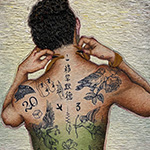The Third Line is pleased to announce Neither Here ~ Nor Elsewhere a group exhibition curated by Sanaz Askari. The exhibition brings together a diverse collective of artists from across Africa and Asia. Selected artists include Faissal El-Malak, Hayv Kahraman, Mahsa Merci, Michael Ho, Omar Mismar, Sam Samiee, Sophia Al-Maria, Soufiane Ababri, Tahmineh Monzavi, and Yumna Al-Arashi, all of whom convey narratives of identity, desire, displacement, and resistance in response to prevailing cultural and political conditions shaped by migration, censorship, and societal marginalisation.
The exhibition centres on the tension between fear and fantasy, the public and the private, as experienced by marginalised bodies existing within distinct socio-political frameworks. The artists challenge social hierarchies and restrictions that limit the spaces they inhabit, pushing back against the forces that constrain their identities while revealing inner desires, embracing fluidity, and exploring the fragmentation of preconceived settings. Through a reimagining of the corporeal in relation to its surroundings, their explorations reveal transformative possibilities for existence.
The works span a range of disciplines, including photography, video art, and works on paper and canvas, exploring mechanisms of control—such as social norms, gender standards, and moral codes—highlighting their pervasive influence and questioning their legitimacy.
Faissal El-Malak creates playful, fantasy-like folkloric imagery and paintings that reference themes of identity and displacement, reflecting on the intersections of personal and collective histories often overlooked or suppressed.
Hayv Kahraman confronts the fragility of, and trauma imposed on, the gendered body while also asserting its power.
Mahsa Merci positions the politicised body as a form of expression, transgression, and liberation. She paints her friends with their backs turned to the viewer, concealing their identities while highlighting their multifaceted personas in public spaces. The number 3, tattooed on the back of her subject, symbolizes the three personas her character embodies, each hidden from the others.
Michael Ho’s film hints at Chinese authority’s control, using the karaoke room as a communal safe space for discussing the forbidden and the profane.
Omar Mismar draws on personal experience, social anxieties, and his search for love in The Path of Love, a neon installation that engages themes of belonging and marginalisation in the digital realm, particularly on apps, where the potential for connection is amplified and complicated.
Sam Samiee’s portraits challenge the hegemony of Western figuration by harnessing agency to depict young men from Eastern Islamicate nations in intimate, staged moments. Drawing on the calligraphic style of Nastaliq, the series reclaims the beauty and complexity of male figures beyond Western standards, confronting distorted historical narratives and inviting a fresh, humanising gaze.
Sophia Al-Maria engages with science fiction and speculative storytelling, envisioning chaos and destruction fueled by sensual energy. Her work presents the end of the world as a love story, emphasising humanity’s futility in the cosmos.
Soufiane Ababri draws attention to everyday life in the streets of Paris or his other home in Tangier, examining the nuanced and layered experience of dual marginalisation in both places. Through his intimate and vulnerable depictions, he explores the intersections of race, intimacy, and identity, capturing the quiet resistance of those who navigate spaces where they are both hyper-visible and invisible. Ababri’s work often challenges societal stereotypes and power structures, presenting moments of tenderness and strength that redefine what it means to exist on the margins.
Tahmineh Monzavi reflects on alienation, misogyny, the historical suppression of women, and the taboos that seek to constrain and shame women’s bodies. In her video OXYS—a reference to oxytocin (the “love hormone”)—she contemplates the metaphor of a woman’s body as pregnant, incubating love as a way to cope with the solitude of imprisonment, even though she is not physically pregnant.
Yumna Al-Arashi explores fragmented female bodies, presenting them as sites of vulnerability and strength, while challenging societal perceptions of femininity and identity.
In this group exhibition, fantasy becomes an emancipatory force—a gateway for coping, dismantling traditional power structures, and allowing bodies to spiral freely into realms of otherness. Fantasy becomes a tool for both critique and healing, allowing for the subversion of oppressive realities and the exploration of alternative modes of existence, venturing into dreamlike landscapes of liberation and imagination.
Press release from The Third Line
Image: Mahsa Merci. Let Me Grow. 2022. Oil and silicon on canvas. 76 x 60 cm. Image courtesy of the artist and The Third Line, Dubai



